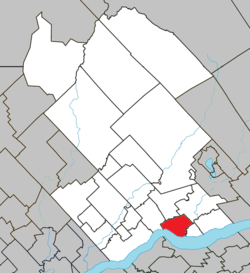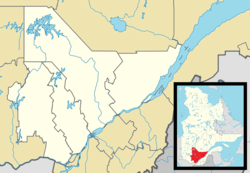Cap-Santé, Quebec
| Cap-Santé | ||
|---|---|---|
| City | ||
 |
||
|
||
| Motto: Ex Unitate Vires | ||
 Location within Portneuf RCM. |
||
| Location in central Quebec. | ||
| Coordinates: 46°40′N 71°47′W / 46.667°N 71.783°WCoordinates: 46°40′N 71°47′W / 46.667°N 71.783°W | ||
| Country |
|
|
| Province |
|
|
| Region | Capitale-Nationale | |
| RCM | Portneuf | |
| Settled | 1679 | |
| Constituted | July 1, 1855 | |
| Government | ||
| • Mayor | Jean-Yves Nobert | |
| • Federal riding | Portneuf—Jacques-Cartier | |
| • Prov. riding | Portneuf | |
| Area | ||
| • Total | 69.80 km2 (26.95 sq mi) | |
| • Land | 54.79 km2 (21.15 sq mi) | |
| Population (2011) | ||
| • Total | 2,996 | |
| • Density | 54.7/km2 (142/sq mi) | |
| • Pop 2006-2011 |
|
|
| • Dwellings | 1,327 | |
| Time zone | EST (UTC−5) | |
| • Summer (DST) | EDT (UTC−4) | |
| Postal code(s) | G0A 1L0 | |
| Area code(s) | 418 and 581 | |
| Highways |
|
|
| Website | www |
|
Cap-Santé is a town in the Canadian province of Quebec. It is the county seat of Portneuf Regional County Municipality and was as well the county seat of the designated Portneuf County.
The name of the town means "Cape Health". Cap-Santé is on the northern bank of the Saint Lawrence River, 40 kilometres (25 mi) west of Quebec City. Legend has it that this community’s name was coined when soldiers suffering from an unknown disease miraculously recovered from a cure discovered in the village.
The old settlement is situated just west of the nearby Jacques-Cartier River and on the embankment of the Saint Lawrence River.
The first settlers arrived around 1679, and in 1714 the village became an official parish.
The present-day church, a historical-registered building, was built from 1754 to 1767. Interrupted during construction by the Seven Years’ War (1756–63), it is one of the last buildings to be constructed under the French regime. The church has a facade and two towers, a baroque interior, a neoclassical reredos, and two-tiers of openings on the bell tower, a presbytery (designed by architect Charles Baillargé in 1849) featuring five neatly lined dormer windows. A cemetery encircles the square, leading to the river below.
The Place de l’Église square is crowned with old wells dating back to 1799.
Vieux Chemin street was built along the same geographical line as that Chemin-du-Roy, the first road linking Montreal and Quebec City in the 18th century. Wooden and stone homes dot the narrow and shaded street that borders the cape. This street was designated as one of Canada’s most beautiful streets by the national newspaper, the Globe and Mail.
The quay is on the Saint Lawrence.
In 1759, during the English conquest, the Chevalier de Lévis built Fort Jacques Cartier at the mouth of the Jacques-Cartier river (also named after the famous explorer) from materials originally destined for construction of a church. The following year, in the same place, Lévis attempted unsuccessfully together with 7000 men to recapture Quebec City from the English. Today, virtually nothing remains of the fort, which is also situated on private land inaccessible to the public on the 'Plateau Jacques-Cartier' district of the municipality. Close by, is the Allsopp House (late 18th century), an old seigneurial manor named after the Allsopp family, now a private property registered as a historical building.
...
Wikipedia


